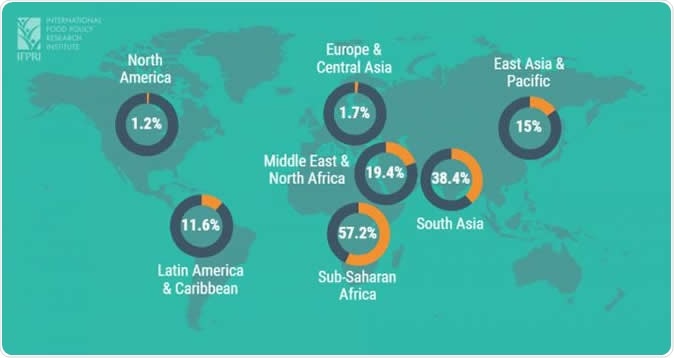The cost issues are most likely to come from the fruit, vegetable and animal-derived foods, with wide price variations in different parts of the world. Most of these people are in sub-Saharan Africa and south Asia, at about 57% and 38% respectively.
The diet was designed by the EAT-Lancet Commission on Food, Planet, Health, in the earlier part of 2019 and would have put an end to food unsustainability and malnutrition issues if applied (along with better farming practices and reduced food waste/loss) to the estimated 10 billion-strong world population of 2050. The scientists left out a component of primary importance, however – can people afford to eat that way? The only question is, was this deliberate?

New research finds the EAT-Lancet diet for human and planetary health is unaffordable for 1.58 billion people, mostly in the developing world. Pictured: the proportion of people in each region whose daily income is less than the local cost of the EAT-Lancet diet. Image Credit: IFPRI
The answer is a firm YES. In the words of Will Masters, part of the current research team evaluating the recommended diet, “When formulating this pioneering benchmark diet - addressing individual health outcomes as well as the health of the planet - the Commission deliberately did not take its cost into account.” Masters is an economist, and part of a multidisciplinary team that also includes food policy experts and nutritionists.
The EAT-Lancet plan
The EAT-Lancet reference diet comprises a whole lot of vegetables and fruits, whole grains, legumes, nuts and unsaturated oils, seafood and poultry, with little red or processed meat, refined flour, added sugar, and starchy vegetables.
The current study had three aims: compare diet cost to national per capita household income; find the proportion of people who cannot afford the most budget-friendly version of the EAT-Lancet diet because it takes more than their per capita income; and compare the affordability of this reference diet to that of the lowest-cost nutritionally adequate diet.
Estimating how much the diet would cost for a typical earth-dweller in 2011, the team calculated a global median of $2.84, which comes to almost 90% of the daily per capita income of a low-income household in a developing country. This is obviously more than people can spend on food on a daily basis. In fact, the diet is out of reach for 1.58 billion people who have a total income that is less than this.
About 80% of these people come from middle-income countries, where the cost of this diet comes to about 27% (well over a quarter) of the daily per capita household income in the upper crust, but more than half (52%) in the lower half of this category.
On the other hand, it takes up only 6% of the per capita income in richer economies, which is in many cases less than is currently spent on food in these countries.
When the team did a head-to-head economic comparison of the EAT-Lancet diet with the most budget-friendly diet that contained all 20 essential nutrients in a balanced composition, they found that the former was 64% more expensive. The cost issues are primarily due to the inclusion of much more meat and meat products, fruits, and vegetables than required for a nutritionally adequate diet. These amounts far exceed currently consumed quantities in the world’s poorer countries. Over 30% of the cost comes from fruit and vegetables, 19% from nuts and legumes, 15% from animal-source foods, ad 13% for a separate dairy category. All animal-sourced foods together came to almost a third of the cost in poorer countries but 26% in high-income countries.
The study
To calculate these figures, they looked at retail prices for standardized versions of each food item, comparing prices for over 740 food items in about 160 countries. The figures came from the International Comparison Program, a joint project by the World Bank with national statistical organizations. They used these prices to put together the lowest-cost menu that would satisfy the requirements of the EAT-Lancet diet for each of these countries.
They repeated the exercise, formulating the lowest-cost diet plan that contained individual nutrients at adequate levels. They finally compared food costs in each country with household spending patterns and per capital income, using the PovcalNet system from the World Bank.
And Masters clarifies that the figure of 1.58 billion is actually the lower limit of expected. When food preparation costs, and the need for essential non-food spending, is taken into account, many more people than this will fall through the meshes of this diet plan, he says.
Implications of the study
Of course, the study is limited by its strict insistence on cost as a criterion of food choice. In many countries, people choose not the least expensive item but one which is most easily prepared, meets their tastes, or is preferred for other reasons. In addition, the prices used to compute these models are at 2011 prices and use national-level data. Within countries, however, prices can vary widely between regions and seasons. There could also be disagreement regarding the exact nutritional composition of the foods used to build up the alternative menu models.
Despite all this, the basic premise of the current study holds good: dietary plans will fail to accomplish their goal, however well-designed they are, if people can’t afford them. Lead author Kalle Hirvonen sums up obstacles and goals in achieving universal food sustainability: “Even if many poor consumers were to aspire to consume healthier and more environmentally sustainable foods, income and price constraints frequently render this diet unaffordable. Increased earnings and safety-net transfers, as well as systemic changes to lower food prices, are needed to bring healthy and sustainable diets within reach of the world’s poor.”
Journal reference:
Affordability of the EAT–Lancet reference diet: a global analysis Hirvonen, Kalle et al. The Lancet Global Health, https://www.thelancet.com/journals/langlo/article/PIIS2214-109X(19)30447-4/fulltext